How Do Bug Zappers Work? (Best Ones to Use)
Do you have a bug problem? If so, you may want to consider using a bug zapper. Bug zappers use ultraviolet light to kill insects, and they are very effective at getting rid of bugs.
In this blog post, we will discuss how bug zappers work and why they are so effective at getting rid of bugs. We will also provide information on the different types of bug zappers available on the market today.
What is a Bug Zapper?
Mosquitoes can’t stand it and get sick when they come into contact with bug zappers. Bug zappers are devices that use ultraviolet light to attract insects and then zap them. They use an electric shock to kill the insects.
Insects that are attracted to ultraviolet light are the most vulnerable to bug zappers. The buzzing sound made by the device when electrocuting a bug gives it its name.
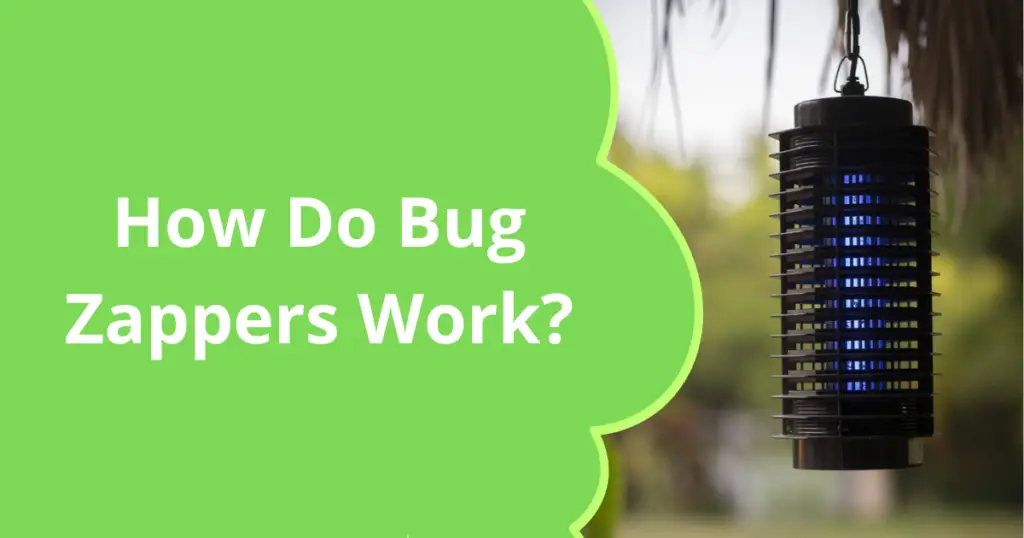
How Do Bug Zappers Work?
Despite the fact that insect zapping machines have improved significantly in terms of safety and bug luring potential, they are essentially unchanged. Insects are lured into a high voltage electrical wire mesh grid where they are electrocuted with an ultraviolet light bulb. The bulbs and wires are contained in a protective plastic or grounded metal cage that is encased in light.
The majority of zappers utilize ultraviolet light-emitting fluorescent lights to attract pests. Why are insects more drawn to ultraviolet light? Interesting fact: UV light reveals the flower patterns that insects are attracted to.
The bug enters the gap between the mesh wires when it sees the UV light from the bug zapper bulb. The insect completes the electric circuit and voltage floods across the gap, instantly killing the bug. The “ZAP” sound is produced by closing of the circuit.
Pros and Cons of Bug Zappers
Bug zappers can be a handy tool for keeping pesky insects at bay, but like any device, they have their pros and cons. Let’s take a closer look at the advantages and disadvantages of bug zappers, so you can make an informed decision.
Pros:
- Effective against certain insects: Bug zappers are known for their ability to attract and eliminate a wide range of flying insects. They are particularly effective against non-harmful invertebrates like beetles and moths. I remember one summer when my backyard was overrun with moths, and using a bug zapper made a noticeable difference in reducing their numbers.
- Easy to use: Bug zappers are generally straightforward to set up and operate. Most models simply require plugging them in or inserting batteries, and they are ready to go. It’s as easy as hanging them up or placing them on a table, and they’ll start attracting insects right away.
- Chemical-free solution: Unlike some insect control methods that rely on pesticides or chemicals, bug zappers offer a chemical-free solution. They use ultraviolet light to attract insects and an electric shock to eliminate them. This can be a relief for those who prefer more natural pest control methods.
Cons:
- Limited effectiveness against mosquitoes: One of the significant drawbacks of bug zappers is their limited effectiveness against mosquitoes. While they can eliminate some mosquitoes, these insects are not primarily attracted to ultraviolet light. Mosquitoes are more attracted to carbon dioxide and human scent. So, if you’re dealing with a mosquito problem, you might want to consider alternative methods like using mosquito traps or repellents.
- May harm beneficial insects: Bug zappers are indiscriminate when it comes to insects. While they target annoying pests, they can also inadvertently harm beneficial insects like bees and butterflies. These insects play vital roles in pollination and maintaining ecological balance, so it’s essential to consider the potential impact on the overall ecosystem.
- Noise and visibility: Bug zappers emit a distinctive buzzing sound when electrocuting insects, which can be a bit annoying, especially if you’re trying to relax in your backyard. Additionally, some people find the bright ultraviolet light emitted by bug zappers to be visually distracting. It’s a matter of personal preference, but it’s worth considering if you’re sensitive to noise or light.
I vividly remember a summer camping trip where we set up a bug zapper near our picnic area. It was great for keeping away bothersome flies and moths. However, we soon realized that it attracted a large number of bees as well. We didn’t want to harm the bees, so we ended up relocating the bug zapper away from the eating area to avoid any accidental harm to these important pollinators. It reminded us of the need to be mindful of the potential impact on beneficial insects when using bug zappers.
Bug zappers have their advantages and disadvantages. They are effective against certain insects, easy to use, and provide a chemical-free pest control option. However, they may not be the best choice for targeting mosquitoes and can inadvertently harm beneficial insects. It’s important to weigh these factors and consider alternative methods based on your specific pest control needs.
Do Bug Zappers Actually Work?
Unfortunately, many biting bugs are resistant to UV light produced by bug zappers, like mosquitoes and biting gnats. Traditional bug zappers will eliminate a large number of non-harmful invertebrates. They may even kill a greater number of beneficial insects than annoying ones.
Mosquitoes are more attracted to carbon dioxide (in your breath) and water vapor (in your sweat) than UV radiation from zappers. However, there are bug zappers that produce both UV light and CO2.
Keep zappers out of the reach of children and pets. Zappers should be kept at least 6 feet from any person or animal that might come into contact with them, including food preparation areas. Germs that survive on dead insect parts can become airborne or settle on people or other animals if insects are electrocuted.
While bug zappers aren’t always successful in keeping harmful biting insects at bay, there is another alternative to keep the insects away altogether. Yellow bug lights may be used to light patios and decks. Because the yellow coating filters out the blue spectrum light that attracts a large number of flying insects, far fewer bugs will appear.
Tips for Using Bug Zappers Effectively
Bug zappers can be a valuable tool in your battle against pesky insects. To make the most of your bug zapper and ensure its effectiveness, here are some helpful tips to keep in mind:
- Proper Placement: The placement of your bug zapper plays a crucial role in its effectiveness. Hang or position the bug zapper in areas where insects are most likely to gather, such as near outdoor seating areas, patios, or entryways. I remember setting up a bug zapper near our backyard barbecue, and it made a noticeable difference in keeping the flying pests away from our delicious grilled food.
- Keep it Clean: Regular maintenance and cleaning of your bug zapper are essential to maximize its performance. Dead insects can accumulate on the electric grid or collection tray, potentially reducing its effectiveness. Take the time to clean the bug zapper periodically, following the manufacturer’s instructions. Trust me, a clean bug zapper is a happy bug zapper!
- Time it Right: Turn on your bug zapper during the peak insect activity times, typically around dusk and dawn. This is when mosquitoes and other flying insects are most active. By aligning the operation of your bug zapper with their natural behavior, you’ll have a better chance of attracting and eliminating them.
- Consider Other Factors: While bug zappers can be effective, they shouldn’t be your sole method of insect control. Consider implementing other strategies in combination with your bug zapper, such as removing standing water to eliminate mosquito breeding grounds or using insect repellents when spending time outdoors. It’s all about creating a comprehensive approach to keep those bugs at bay.
- Be Mindful of Beneficial Insects: As mentioned earlier, bug zappers can inadvertently harm beneficial insects like bees and butterflies. If you’re concerned about their well-being, try to place the bug zapper away from areas where these insects are most active. This way, you can still target nuisance insects while minimizing any unintended harm to the helpful ones.
By following these tips and being mindful of your bug zapper’s placement and maintenance, you can optimize its effectiveness in reducing flying insect populations around your home or outdoor spaces. Remember, it’s not just about eliminating bugs but creating a more comfortable and enjoyable environment for you and your loved ones.
What Should You Consider When Choosing a Bug Zapper?
Many of the best bug zappers operate on the same basic principle. They include an ultraviolet (UV) light that insects cannot avoid. When bugs approach the light, they are killed by an electrified wire grid that comes into touch with them. Dead bugs drop into a disposable collection tray, which may be emptied as often as necessary (usually every 2 to 7 days, depending on the severity of infestations).
Keep the following points in mind while selecting the best bug zapper for either an indoor or outdoor location.
Bug Zapper Power Sources
Bug zappers may be used with a wide range of power sources, including both plug-in electric and battery solutions. If your bug zapper is outside, it will require an outside outlet. Instead, use an extension cord, but make sure it’s marked for usage outdoors.
Portable and lightweight bug zappers are ideal for camping excursions, tailgate parties, and other outdoor activities. They may be hung from trees or placed on a table. Racquet-type zappers, which use electricity to stun the bugs they contact, are another battery-operated option.
The newest, most adaptable outdoor bug zappers are powered by the sun. To charge their internal batteries, simply place them in direct sunshine during the day, then use them to zap pests at home or on the go at night.
Outdoor vs. Indoor Bug Zappers
While they perform the same duty, outdoor zappers are built to last better in the elements than their indoor counterparts. They also tend to be bulkier and have larger collection plates. Hanging electric bug-zapper machines are a popular and attractive choice for a patio or sitting area.
Indoor bug-zappers are available in a variety of colors, such as white UV lights rather than the sometimes-distracting deep purple seen in outdoor versions. Indoor bug-zapper systems that work best tend to be wall fixtures and countertop units because they are the simplest to set up indoors. Before you buy, check the label to see if certain types of bug zappers function well both in and outdoors.
Mosquito Bait For Bug Zappers
Mosquitoes are attracted to octenol, the chemical found in human breath and sweat that mosquitoes find irresistible. Lures with octenol are available in small, portable tubes that fit into the zapper’s collection tray. Mosquitoes are drawn to one lure for up to three months. Alternatively, you may use a handheld zapper to kill them manually.
Coverage Area of a Bug Zapper
When shopping for an outdoor bug zapper, the product should have a coverage area listed, often by acreage. While there are no industry standards, typically a larger coverage area means brighter UV lights in the zappers so that bugs see them from a greater distance.
The U.S. Environmental Protection Agency lists bug zappers as “pesticide devices.” While the EPA admonishes manufacturers not to make false claims about their products, they do not regulate the bug-zapper industry, so exaggerated claims may occur.
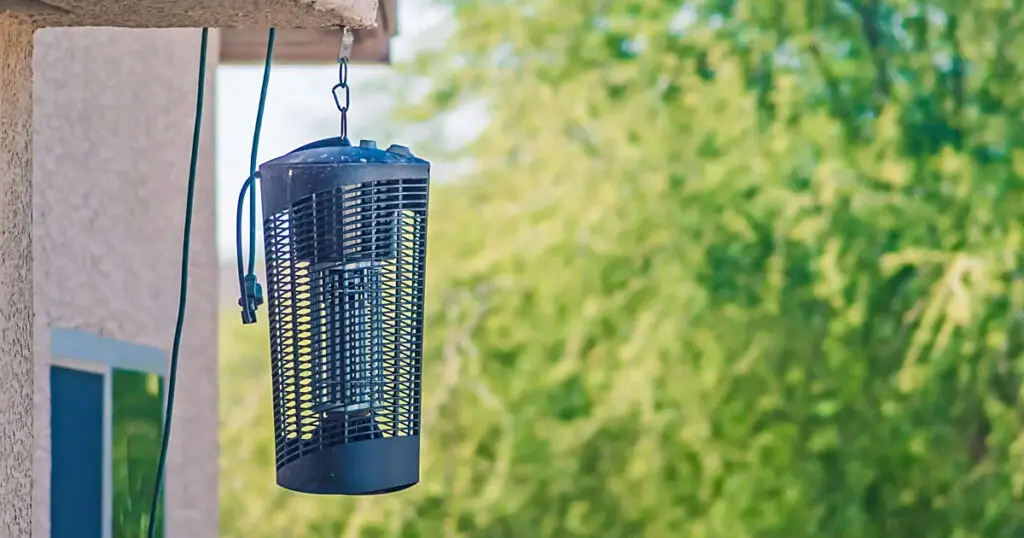
Best Outdoor Bug Zapper
The FVOAI Outdoor Bug Zapper is perfect for your patio, balcony, or backyard. It uses UV light to attract bugs and covers 1500 square feet.
Features of the FVOAI outdoor bug zapper include:
- 4200 volts
- Covers an area of 1500 sq. ft
- Waterproof
- The trap is made of ABS plastic, ensuring that neither people nor pets can come into direct contact
- Has a removable bottom tray to collect bugs and debris
- Comes with a brush to clean the trap
Learn more about the FVOAI outdoor bug zapper here. Remember, to kill more mosquitoes you’ll want to get octenol baits to put into the tray.
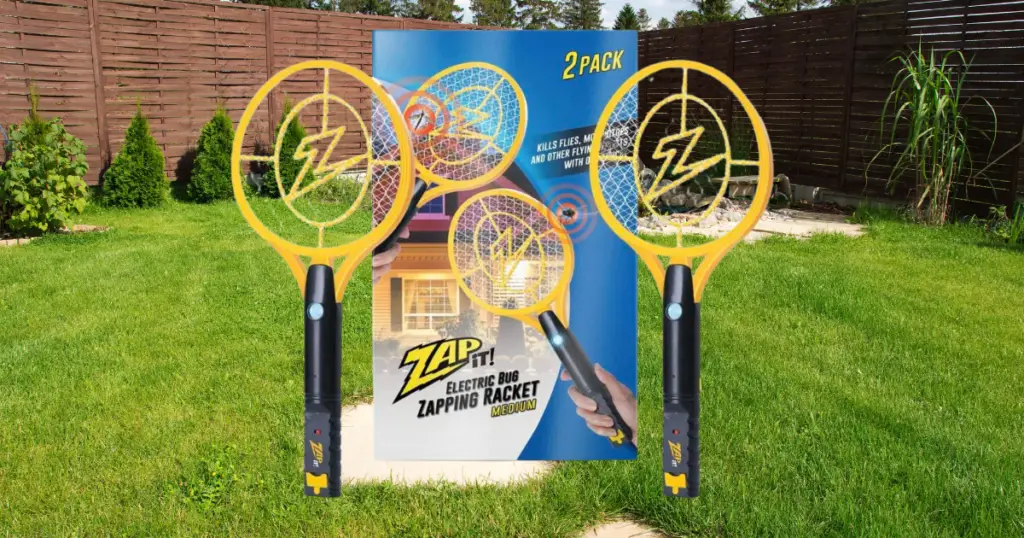
Best Handheld Racquet Bug Zapper
The Zap It! Bug Zapper Racquet is a great choice for a handheld bug zapper. It is lightweight, battery-powered, and easy to use. Just press down on the button and swing at whatever pest in bothering you.
Features of the Zap It! handheld bug zapper include:
- 3500 volts
- Comes in three different sizes
- Compact and lightweight (13.05 ounces)
- Triple-layer safety mesh for extra protection
- Batteries are included
Take a look at the Zap It! Electric Bug Swatter at Amazon now.
Alternatives to Bug Zappers
Bug zappers may not be the ideal solution for everyone, and that’s perfectly fine. If you’re looking for alternatives to bug zappers to keep those pesky insects at bay, here are some options to consider:
- Citronella Candles: Citronella candles are a popular choice for outdoor gatherings. Not only do they provide a pleasant aroma, but they also emit a scent that repels mosquitoes. I remember hosting a backyard barbecue, and the soft glow of citronella candles not only added to the ambiance but also helped keep the mosquitoes away, allowing us to enjoy the evening without constant swatting.
- Insect Repellent: Using insect repellents can be an effective way to ward off bugs. Look for products containing ingredients like DEET, picaridin, or oil of lemon eucalyptus. Apply the repellent according to the instructions before heading outdoors, and reapply as needed. It’s always a good idea to have a bottle of insect repellent handy, especially when going on hikes or spending time in areas known for high insect activity.
- Mosquito Nets: If you want to enjoy the outdoors without the annoyance of buzzing insects, consider using mosquito nets. They can be particularly useful when camping or sleeping outdoors. I recall a camping trip where we hung a mosquito net over our sleeping area, creating a peaceful sanctuary free from any unwanted visitors.
Remember, bug zappers are not the only solution to combatting insects. Exploring alternatives can provide you with a range of options that suit your preferences and needs. Whether it’s using citronella candles, employing insect repellents, or incorporating natural plant repellents, there are plenty of ways to create bug-free zones and make the most of your outdoor spaces.
Conclusion
If you’re in the market for a bug zapper, there are a few things you should keep in mind. Outdoor zappers are designed to withstand the elements better than indoor ones, and they also tend to be bigger with larger collection trays. The sun powers the newest, most versatile outdoor bug zappers. Just position them in sunlight during the day to charge their internal batteries, and switch them on at dusk to start zapping pests at home or on the go.
But beware: Anyone, human or insect, who touches the grid when the button is depressed will get a shock. To prevent accidental zaps, look for a handheld zapper with a protective layer. Keep pets out of swatting range, and remind kids that electric fly swatters are not toys.
- Bug zappers that kill mosquitoes amp up their effectiveness with bait containing octenol, the chemical found in human breath and sweat that mosquitoes find irresistible.
- Octenol comes in small, packed lures that adhere to the inside of the zapper’s collection tray.
- One lure attracts mosquitoes for up to three months. Or grab a handheld zapper and hunt the mosquitoes manually.

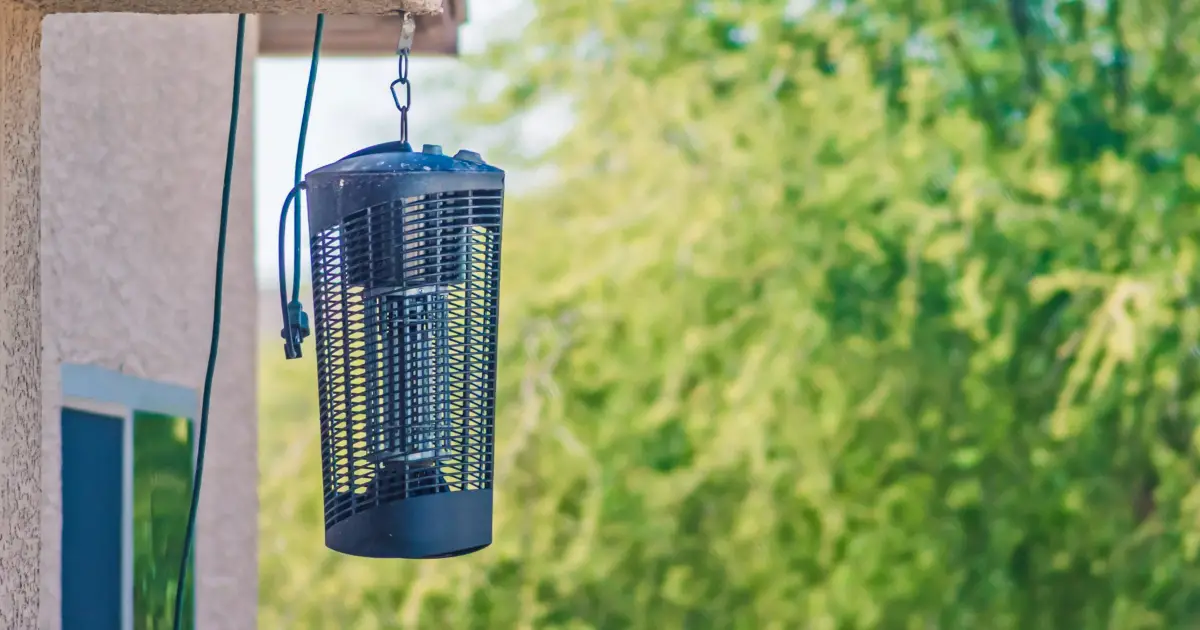

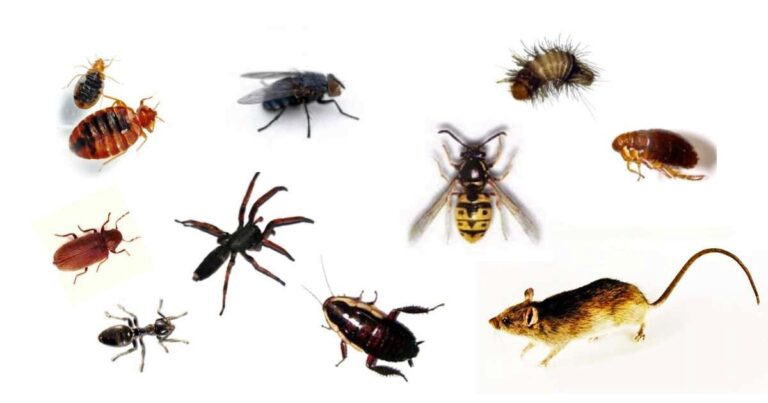
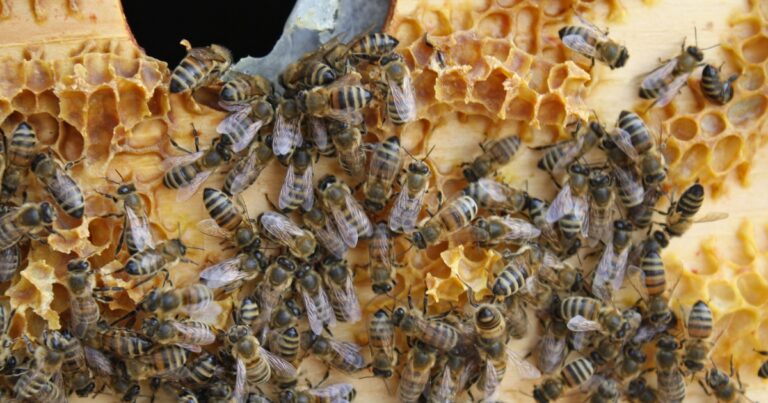

One Comment